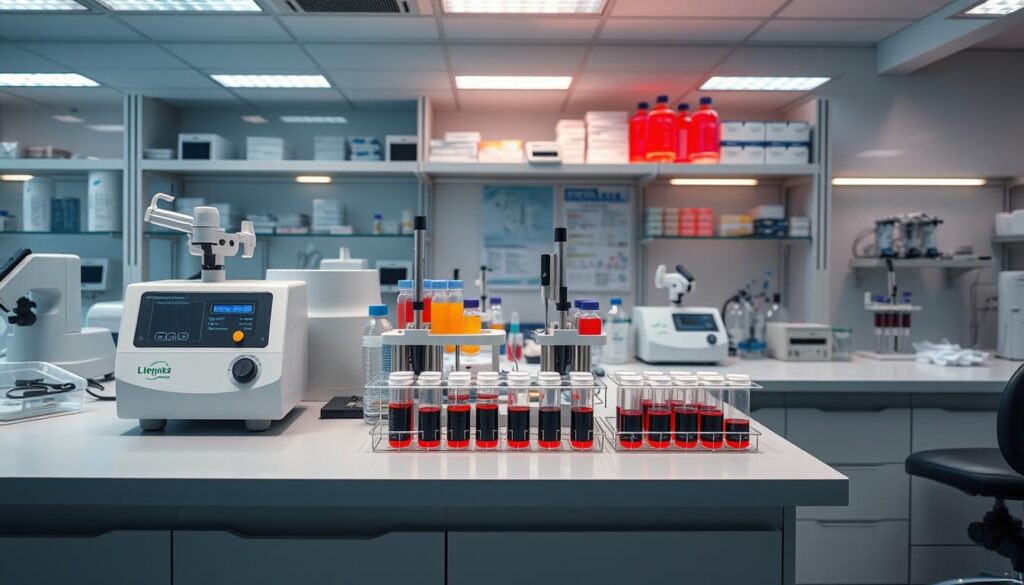Quality Control Measures in Blood Sample Analysis: A Comprehensive Guide
In the world of blood analysis, a key question is: what’s the role of quality control? It ensures the accuracy and reliability of blood test results. We’ll look at how to implement effective quality control to avoid errors and enhance patient care.
Quality control in blood sample analysis is vital. It affects the accuracy of results and patient care. We’ll discuss the best practices, including quality control measures and following regulatory standards.

Most blood product units meet international quality standards. They have a mean hematocrit of 69.5 ± 7.24 g/dl. Also, 98% of units meet the standard of
Understanding Blood Analysis Quality Control Fundamentals
Quality control in blood analysis is key for accurate test results. About 70% of healthcare choices rely on lab tests, the CDC says. Labs must follow quality control steps to ensure test accuracy, including understanding blood test abbreviations.
The European Federation of Clinical Chemistry and Laboratory Medicine (EFLM) suggests checking phlebotomy quality often. This is vital for the reliability of test results.
Key Components of Quality Control Systems
Quality control in blood analysis includes several important parts:
- Regular calibration and maintenance of equipment
- Use of reference ranges and optimal ranges for interpreting results
- Implementation of quality control protocols in blood analysis
Regulatory Requirements and Standards
Labs must follow rules and standards, like those from CLSI and ISO. This makes sure tests are done right.
Role of Quality Control in Laboratory Accuracy
Quality control is crucial for lab accuracy. It helps labs find and fix errors, making sure test results are reliable. By following quality control steps, labs can ensure accurate results for healthcare decisions.
Essential Blood Analysis Quality Control Measures
We know how vital quality control is in medical labs. It stops mistakes and makes sure results are right. In haematology labs, it’s key for accurate patient care. Calibration and standardisation keep instruments working well over time.
Quality control samples are crucial. They check if results are correct and if tests are working right. Quality assurance programs make sure tests are done correctly. They track every step and do regular checks.
Some important quality control steps include:
- Checking if results are accurate
- Following testing procedures to avoid mistakes
- Joining external quality control programs to check overall performance
Accreditation agencies need labs to join quality control programs, and NABL Accredited Labs play a crucial role in maintaining these standards. This covers all tests done often in haematology labs. We stress the need for quality control to keep blood products and tests safe and accurate.
Implementing Advanced Quality Control Protocols
To get accurate blood test results, it’s key to use advanced quality control. This means following the best ways to test blood and keeping high standards. Labs use internal checks and join external programs to ensure reliable blood test result time.
Internal Quality Control Procedures
Internal checks, like audits and checklists, find ways to get better. They make sure quality steps are followed well. Daily use of special control sera is advised for each test.
External Quality Assessment Programs
Joining at least one external quality program monthly is vital. It makes sure labs meet quality standards and follow guidelines.
Documentation and Record Keeping
Keeping good records is crucial for quality in blood analysis. This includes keeping track of internal checks, external programs, and staff training.
Staff Training and Competency Assessment
Training staff is key to quality blood analysis. They need to know about internal checks, external programs, and guidelines.
| Quality Control Measure | Description |
|---|---|
| Internal Quality Control Procedures | Regular audits and quality control checklists |
| External Quality Assessment Programs | Participation in at least one program with monthly assessments |
| Documentation and Record Keeping | Storing records of internal quality control procedures, external quality assessment programs, and staff training and competency assessment |
| Staff Training and Competency Assessment | Training on internal quality control procedures, external quality assessment programs, and blood analysis qc guidelines |
Conclusion: Ensuring Sustainable Quality Control in Blood Analysis
Keeping a strong quality control system is key for accurate blood sample analysis. At Acme Laboratories, we know how vital it is to always improve quality for the best patient care.
Labs need to have detailed plans for every step in blood testing. This means regular checks, quality control lists, and training for staff. It helps us see where we can get better.
Joining external quality checks, like those from the College of American Pathologists, is also crucial. It lets us compare our work to the best standards and find any problems.
By focusing on quality control and following the latest advice, we make sure patients get the right blood test results. This is a big part of good healthcare.







